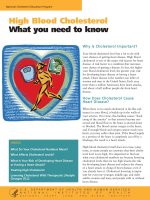Guide to Living with Diabetes Preventing and Treating Type 2 Diabetes— Essential Information You and Your Family Need to Know ppt
Bạn đang xem bản rút gọn của tài liệu. Xem và tải ngay bản đầy đủ của tài liệu tại đây (9.57 MB, 289 trang )
American Medical Association
Guide to
Living with Diabetes
Preventing and Treating Type 2 Diabetes—
Essential Information You and Your
Family Need to Know
American Medical Association
Boyd E. Metzger, M.D.
John Wiley & Sons, Inc.
ffirs.qxd 7/11/06 2:14 PM Page iii
ffirs.qxd 7/11/06 2:14 PM Page ii
American Medical Association
Guide to
Living with Diabetes
ffirs.qxd 7/11/06 2:14 PM Page i
ffirs.qxd 7/11/06 2:14 PM Page ii
American Medical Association
Guide to
Living with Diabetes
Preventing and Treating Type 2 Diabetes—
Essential Information You and Your
Family Need to Know
American Medical Association
Boyd E. Metzger, M.D.
John Wiley & Sons, Inc.
ffirs.qxd 7/11/06 2:14 PM Page iii
This book is printed on acid-free paper.
Copyright © 2006 by the American Medical Association. All rights reserved
Published by John Wiley & Sons, Inc., Hoboken, New Jersey
Published simultaneously in Canada
Design and composition by Navta Associates, Inc.
Credits: Bar graph on insulin sensitivity adapted from the work of Richard N. Bergman,
Ph.D: 11; National Eye Institute, National Institutes of Health: 184; © PhotoDisc: 72, 177; Think-
stock/PunchStock: 116 (right); USDA photos by Ken Hammond: 116 (left), 198, 225, and 244.
No part of this publication may be reproduced, stored in a retrieval system, or transmitted in any
form or by any means, electronic, mechanical, photocopying, recording, scanning, or otherwise,
except as permitted under Section 107 or 108 of the 1976 United States Copyright Act, without
either the prior written permission of the Publisher, or authorization through payment of the
appropriate per-copy fee to the Copyright Clearance Center, 222 Rosewood Drive, Danvers, MA
01923, (978) 750-8400, fax (978) 646-8600, or on the web at www.copyright.com. Requests to the
Publisher for permission should be addressed to the Permissions Department, John Wiley &
Sons, Inc., 111 River Street, Hoboken, NJ 07030, (201) 748-6011, fax (201) 748-6008, or online
at />The recommendations and information in this book are appropriate in most cases and current as
of the date of publication. For more specific information about a medical condition, the AMA
suggests that you consult a physician.
Limit of Liability/Disclaimer of Warranty: The information contained in this book is not
intended to serve as a replacement for professional medical advice. Any use of the information in
this book is at the reader’s discretion. The author and the publisher specifically disclaim any and
all liability arising directly or indirectly from the use or application of any information contained
in this book. A health care professional should be consulted regarding your specific situation.
For general information about our other products and services, please contact our Customer
Care Department within the United States at (800) 762-2974, outside the United States at (317)
572-3993 or fax (317) 572-4002.
Wiley also publishes its books in a variety of electronic formats. Some content that appears in
print may not be available in electronic books. For more information about Wiley products, visit
our web site at www.wiley.com.
Library of Congress Cataloging-in-Publication Data:
The American Medical Association guide to living with diabetes : essential information you and
your family need to know about preventing and treating type 2 diabetes / American Medical
Association.
p. cm
Includes index.
ISBN-13 978-0-471-75023-9 (cloth)
ISBN-10 0-471-75023-9 (cloth)
1. Non insulin-dependent diabetes—Popular works. I. American Medical Association.
RC662.18.A44 2006
616.4'62—dc22
2006005496
Printed in the United States of America
10 9 8 7 6 5 4 3 2 1
ffirs.qxd 7/11/06 2:14 PM Page iv
Michael D. Maves, MD, MBA Executive Vice President,
Chief Executive Officer
Bernard L. Hengesbaugh Chief Operating Officer
Robert A. Musacchio, PhD Senior Vice President, Publishing
and Business Services
Anthony J. Frankos Vice President, Business Products
Mary Lou White Executive Director, Editorial and
Operations
Boyd E. Metzger, MD Medical Editor
Donna Kotulak Managing Editor/Writer
Pam Brick Writer
Mary Ann Albanese Art Editor
ffirs.qxd 7/11/06 2:14 PM Page v
ffirs.qxd 7/11/06 2:14 PM Page vi
Introduction 1
PART ONE
Type 2 Diabetes: A Modern Epidemic
1 What Is Diabetes? 5
2 Are You at Risk? 19
PART TWO
Preventing Type 2 Diabetes
3 Maintaining a Healthy Weight 33
4 Nutrition Basics for Staying Healthy 45
5 Exercise Your Way to Better Health 69
PART THREE
Diagnosing and Treating Type 2 Diabetes
6 How Do You Know If You Have Diabetes? 87
7 Reaching a Healthy Weight 97
8 Eating a Healthy Diet 107
9 Your Exercise Regimen 123
10 Medication and Blood Sugar Testing 131
11 Experimental Treatments and Special Situations 143
vii
Contents
ftoc.qxd 7/10/06 9:53 AM Page vii
viii CONTENTS
PART FOUR
Complications of Diabetes
12 Acute Complications 159
13 Chronic Complications 165
PART FIVE
Diabetes in Children
14 Type 2 Diabetes in Children 195
PART SIX
Diabetes during Pregnancy
15 Gestational Diabetes 243
Glossary 253
Index 267
ftoc.qxd 7/10/06 9:53 AM Page viii
M
ore than 19 million Americans have diabetes—a condition that
can produce life-threatening complications. Of the two major
forms of diabetes—type 1 and type 2—type 2 comprises 90 to 95 per-
cent of all cases in the United States. An additional 13 million people
have the precursor to type 2 diabetes, called prediabetes. Worldwide,
type 2 diabetes affects more than 190 million people, and some experts
predict that if the current trends continue that figure could surge to
over 300 million by the year 2025.
Diabetes is one of the leading causes of death and disability in the
United States, and annual diabetes-related medical costs total more
than $100 billion. The predicted future increase in the number of cases
is fueled by several factors. Americans are becoming increasingly seden-
tary and overweight; being overweight is the major risk factor for type
2 diabetes. Age is another factor—most cases of type 2 diabetes develop
after age 45. In addition, Hispanic Americans and other minority
groups who have a high incidence of type 2 diabetes make up the
fastest-growing segment of the US population.
The good news is that type 2 diabetes can often be prevented, mainly
by eating a healthy and balanced diet, getting regular exercise, and
keeping your weight within a healthy range. If you are overweight, los-
ing just 5 to 7 percent of your weight (that’s 10 to 14 pounds if you
weigh 200 pounds) and keeping it off can cut your risk in half.
1
Introduction
cintro.qxd 7/10/06 10:07 AM Page 1
If you already have diabetes, close monitoring of your blood sugar
levels along with healthy eating and regular exercise can help you man-
age your condition and avoid serious complications. Even small changes
in your lifestyle can produce big health benefits. This book is designed
to help you learn how to make those changes in your daily life that can
help you avoid type 2 diabetes or, if you have type 2 diabetes, maintain
good control of it and reduce your risk of complications.
2 AMERICAN MEDICAL ASSOCIATION GUIDE TO LIVING WITH DIABETES
cintro.qxd 7/10/06 10:07 AM Page 2
Type 2 Diabetes:
A Modern Epidemic
PART ONE
c01.qxd 7/10/06 10:09 AM Page 3
c01.qxd 7/10/06 10:09 AM Page 4
5
D
iabetes is a medical disorder that affects the way the body uses
food for growth and energy. When you eat, the carbohydrates
(starches and sugars) are broken down into glucose, a simple sugar that
is one of the main sources of fuel for your body. As food is digested,
glucose gets absorbed into the bloodstream, which transports it
throughout the body. Muscle and fat cells respond to signals from a
circulating hormone in the blood called insulin, which is the “key” that
unlocks the “doors” of these cells to enable glucose to enter and do its
work. People who have diabetes either don’t have enough insulin or
their cells have become insensitive, or resistant, to the effects of insulin.
As a result, glucose doesn’t get into the cells and it begins to build up
in the blood. This buildup of glucose in the blood is the hallmark of
diabetes.
Previously known as adult-onset or non-insulin-dependent diabetes,
type 2 diabetes used to develop almost exclusively in people who were
over age 40 and overweight. Over the past decade, however, the num-
ber of children and young adults diagnosed with type 2 diabetes in the
United States has climbed dramatically because of the growing epi-
demic of obesity that often begins in childhood.
The high blood sugar concentration brought on by both forms
of diabetes can cause serious long-term complications such as nerve
damage, heart disease, kidney failure, blindness, and amputation.
What Is Diabetes?
1
c01.qxd 7/10/06 10:09 AM Page 5
An uncontrolled blood sugar level can also cause severe short-term
complications such as loss of consciousness, and can even be fatal. Many
people with type 2 diabetes can control their blood sugar with diet,
exercise, and weight loss, but some need to take sugar-lowering medica-
tions or insulin injections.
Type l Diabetes
Although the major concern of this book is type 2 diabetes, which is far
more common than type 1 diabetes, it is helpful to understand the dif-
ference between the two forms. People with type 1 diabetes completely
lose the ability to produce the hormone insulin. The specialized beta
cells in the pancreas stop generating enough insulin to keep blood sugar
levels normal. This type of diabetes can begin at any age but is most
6 TYPE 2 DIABETES: A MODERN EPIDEMIC
The Endocrine System
The endocrine system is a group of glands and tissues
shown here that secrete hormones into the bloodstream to
coordinate and control many essential body processes.
The pancreas is the organ most involved in diabetes
because its most important job is to regulate blood sugar
(glucose) levels. The pancreas produces the hormones
insulin and glucagon (which regulate the body’s use of
glucose, fats, and proteins). The pancreas also secretes
digestive enzymes that help break down food and convert
it into glucose. The pituitary is the “master gland” that
makes hormones that control several other endocrine
glands. The hypothalamus, just above the pituitary gland
in the brain, controls hormone secretion by the pituitary
and is the main link between the endocrine and nervous
systems. The thyroid gland produces the hormones thyrox-
ine and triiodothyronine, which control the rate at which
cells burn fuel for energy. The four parathyroid glands
release parathyroid hormone, which helps regulate the
level of calcium in the blood. The adrenal glands produce
hormones including corticosteroids (which influence
metabolism and the body’s response to stress) and epi-
nephrine, or adrenaline (which increases blood pressure
and heart rate during times of stress). The ovaries produce
the female hormones estrogen and progesterone; the
testicles produce male hormones (androgens, primarily
testosterone).
Pituitary
Hypothalamus
Thyroid
Parathyroid
Glands
Adrenal
Glands
Ovary
Pancreas
Testicle
c01.qxd 7/10/06 10:09 AM Page 6
often diagnosed in young people. The peak time of onset is between
ages 8 and 18.
Type 1 diabetes is an autoimmune disorder in which the immune sys-
tem mistakenly identifies specific body tissues—in this case the beta
cells of the pancreas—as foreign and attacks and destroys them. The
precise cause of this error in immune function is unknown, but experts
think that some people are born with a genetic susceptibility to it.
Then, at some point in their life, an environmental trigger such as a
virus or a toxin activates this genetic susceptibility to bring on the
errant immune response that produces type 1 diabetes.
The symptoms of type 1 diabetes tend to come on quickly and
severely, unlike those of type 2 diabetes, which often remain unnotice-
able over a period of several years. Symptoms of type 1 diabetes include
weakness, weight loss, excessive hunger and thirst, blurred vision, and
increased urine output.
People with type 1 diabetes reach the point at which they do not pro-
duce enough insulin to survive, so for the rest of their lives they must
take regular doses of insulin, usually by injection under the skin. Insulin
cannot be taken by mouth because digestive enzymes would destroy it
before it could reach the bloodstream.
Type 2 Diabetes
People who have type 2 diabetes make insulin, but their cells do not
respond to it in the normal way. The body’s resistance, or lack of sensi-
tivity, to the effects of insulin characterizes type 2 diabetes, formerly
known as adult-onset or non-insulin-dependent diabetes. Many factors
can cause people to have insulin resistance, but being overweight and
physically inactive and eating an unhealthy diet are among the most
important. In the United States, 85 to 90 percent of people with type 2
diabetes are overweight or obese (more than 20 percent over their ideal
body weight).
Type 2 diabetes usually develops after age 40. However, with the
surge in obesity in the United States and around the world, the age at
which this form of diabetes is diagnosed is dropping. Today, very over-
weight children and young adults are developing type 2 diabetes at rates
unheard of just a decade ago. (See chapter 14 to learn more about chil-
dren and type 2 diabetes.)
WHAT IS DIABETES? 7
c01.qxd 7/10/06 10:09 AM Page 7
What Is Type 2 Diabetes?
Type 2 diabetes is a medical disorder in which the body has difficulty
using insulin to control the level of the sugar glucose in the blood.
When type 2 diabetes first develops, the pancreas still produces a lot
of insulin but not enough to maintain the normal processing of
glucose in muscles, fat, and the liver. This decreased ability to process
glucose eventually causes it to build up in the blood, leading to
diabetes.
The early stages of type 2 diabetes, which often last several years,
produce no symptoms. But even without noticeable symptoms, high
8 TYPE 2 DIABETES: A MODERN EPIDEMIC
To be healthy, your body needs to keep its blood
sugar (glucose) level within a narrow range:
between 70 and 110 milligrams per deciliter
(mg/dL) of blood, measured when you have not
eaten for several hours or overnight. The blood
glucose level rises after eating, but in healthy
people it seldom rises above 150 or 160 mg/dL
after meals. Doctors generally measure blood
sugar levels after a person has fasted because
sugar levels can remain above the fasting level for
several hours after eating.
The pancreas is one of the key organs that
maintains blood sugar levels within normal
limits. The pancreas is located across the mid-
section of the body just behind the lower part of
the stomach. The pancreas performs a number of
important functions. For example, it secretes
digestive juices that contain enzymes to break
down food into particles, or molecules, tiny
enough to be absorbed and used by cells. But
perhaps the most important job of the pancreas
is to make insulin, a hormone that controls the
way muscle and fat cells use and store sugar.
After you eat, your intestines break down and
absorb the carbohydrates (or sugars) in the food
and release them into the liver and the blood-
stream, which carries the sugars throughout the
body so that your cells can use them for energy.
As the level of sugar, or glucose, rises in your
blood, the pancreas quickly begins to churn out
insulin, which stimulates muscle and fat cells to
take up excess glucose from the blood. These tis-
sues store the surplus glucose until your body
needs it, bringing the blood glucose level back
into the normal range.
The pancreas also produces a hormone called
glucagon, which has the opposite effect of
insulin. When the glucose in your blood starts to
get too low—such as when you haven’t eaten in
a while or during vigorous exercise—the pan-
creas secretes glucagon to prevent the glucose
level from falling too low. Glucagon signals the
liver and muscle cells to release the glucose they
have stored into the bloodstream to allow the
blood sugar level to rise. Glucagon also stimu-
lates the liver to produce glucose out of protein
found in the body.
In these ways, glucagon keeps the blood sugar
level from dropping too low and causing symp-
toms of hypoglycemia (which can include sudden
hunger, dizziness, shakiness, nervousness, irri-
tability, confusion, and drowsiness). Severe hypo-
glycemia, which can lead to seizures and lack of
consciousness, requires emergency medical treat-
ment. When functioning normally, this delicate
balance between insulin and glucagon precisely
regulates the sugar level in the blood, keeping it
within the healthy range.
The Role of Blood Sugar
c01.qxd 7/10/06 10:09 AM Page 8
glucose levels can damage nerves and blood vessels and cause complica-
tions such as heart disease, kidney failure, stroke, and blindness.
Initially, the pancreas keeps blood sugar normal by releasing more
and more insulin. But when insulin output starts to decline, blood
sugar begins to go up. Eventually, the pancreas becomes exhausted—its
output of insulin falls progressively and the amount of glucose in the
blood continues to rise, while muscle and fat cells are starved of the
energy they need. Over time, this situation can lead to symptoms such
as thirst, weight loss, frequent urination, and lack of energy similar to
the symptoms of type 1 diabetes.
WHAT IS DIABETES? 9
However, this intricate system can become dis-
rupted under certain stresses, such as obesity,
especially when fat is concentrated around the
abdominal area. If your cells are resistant to the
effects of insulin, your body needs more insulin
to maintain normal blood glucose levels. If your
body cannot increase its output of insulin suffi-
ciently, your muscle and fat cells can’t use glu-
cose fully and the liver starts making more
glucose. Blood glucose then increases and can
eventually lead to type 2 diabetes. Elevated blood
glucose is the hallmark of diabetes.
How the Body Processes Glucose
The pancreas and the liver are the two
major organs that help control glucose
levels in the blood. Glucose, which is
absorbed from digested food into the
intestines, is the sugar that cells in the
body use for energy. The pancreas
secretes two hormones, insulin and
glucagon, that have opposite effects in
response to blood glucose levels: insulin
lowers blood glucose and glucagon raises
blood glucose. When blood glucose is
high, the pancreas secretes insulin to stim-
ulate liver, fat, and muscle cells to take in
glucose from the bloodstream. When
blood glucose is low, the pancreas
secretes glucagon to stimulate the liver to
release stored glucose into the blood-
stream and to increase the rate at which
the liver makes glucose.
Pancreas (secretes insulin to
help the liver, muscle, and fat
take in glucose)
Insulin (lowers
blood glucose)
Glucose in the bloodstream
Glucagon
(raises blood glucose)
Glucose released
into the blood-
stream
Fat (takes in
glucose to use for
energy or store)
Muscle (takes in
glucose to use for
energy or store)
Liver (makes glucose and
stores excess glucose)
Glycogen (a form of
glucose stored in the liver)
Small intestine (breaks
down food into sugars)
c01.qxd 7/10/06 10:09 AM Page 9
10 TYPE 2 DIABETES: A MODERN EPIDEMIC
Insulin is a hormone secreted by an organ called
the pancreas. Inside the pancreas are several
hundred thousand clusters of cells called islets.
One type of islet cell, the beta cell, secretes
insulin in response to the rise in glucose in the
bloodstream. Like all hormones, insulin circu-
lates in the bloodstream and can affect the
function of cells, organs, and tissues through-
out the body. The muscle and fat cells in your
body have receptors on their surfaces to which
insulin can attach as it circulates in the blood.
Once insulin attaches itself to a receptor on the
surface of a cell, the cell switches on other func-
tions in the cell that attract and absorb glucose
into the cell from the blood. The cell then con-
verts the glucose into energy or stores it for
future use.
If your pancreas does not make enough
insulin, your muscle cells cannot take in suffi-
cient amounts of glucose for your body’s energy
needs. Without insulin, your fat cells release
their stored energy too fast. The excess fat gets
broken down in the liver to form chemicals
called ketone bodies, which can build up in the
blood and cause a life-threatening condition
called ketoacidosis. Ketoacidosis can lead to dia-
betic coma or even death. You can eat normal
amounts of food but lose weight or even
become malnourished because your body is not
properly processing the food. This can occur if
the pancreas is unable to produce insulin, as in
type 1 diabetes, or if your cells have become
resistant to the effects of insulin and your pan-
creas cannot keep up with the increased
demand for insulin, as in type 2 diabetes.
Insulin was discovered in 1921 in Canada,
and the first insulin preparations for treating
diabetes were developed in 1922. The discovery
of insulin was a major step forward in diabetes
treatment. Before the availability of insulin, peo-
ple with type 1 diabetes died within months to
a few years of their diagnosis. The early insulin
preparations were derived from the pancreases
of cows and pigs. Although these insulin prepa-
rations treated type 1 diabetes successfully in
most affected people, some people had adverse
reactions to impurities in the insulin prepara-
tions. By the 1980s, scientists had discovered
how to make human insulin in large quantities
by inserting copies of the human gene for
insulin production into bacteria and manipulat-
ing the bacteria to make insulin.
Insulin’s Role
Insulin is a hormone that enables muscle and fat cells to take
in glucose (sugar) from the blood to use for energy or store
for future energy needs. In a person with type 1 diabetes,
the pancreas has stopped producing insulin; without insulin,
the cells—even though they have receptors (“keys”) for
insulin and “doors” to let in glucose—do not take in glu-
cose. In a person with type 2 diabetes, the cells have
become unresponsive to insulin; although insulin attaches to
the receptors, glucose has difficulty entering the cells. In both
forms of diabetes, glucose builds up in the bloodstream—
quickly in type 1 diabetes and gradually in type 2 diabetes.
Type 1 Diabetes
Cell
Insulin Receptor
Glucose
Door
Type 2 Diabetes
Cell
Insulin
Key
Glucose
Insulin attaches to receptor
Glucose
enters
cell
How Insulin Works
c01.qxd 7/10/06 10:09 AM Page 10
How Type 2 Diabetes Develops
Type 2 diabetes is a disorder that has two major components: insulin
resistance (when the body is less sensitive or responsive to the hormone
insulin) and reduced ability of the pancreas to make and secrete a suffi-
cient amount of insulin to keep blood glucose at a normal level. Among
healthy people, there is a broad range in sensitivity to insulin, and a per-
son’s sensitivity to insulin can fluctuate at different stages of life and still
keep glucose levels within the healthy range. For example, whites tend
to be more sensitive to insulin than Mexican Americans. Older people
and people who are overweight or obese tend to be less sensitive to
insulin than children and people who are thin or at a healthy weight.
Insulin sensitivity tends to decrease during puberty and during the sec-
ond and third trimesters of pregnancy. These are all normal ranges of
insulin sensitivity in healthy people—their pancreas increases its output
of insulin as the muscle and fat cells become less sensitive to the effects
of insulin and the level of glucose in their blood remains normal.
WHAT IS DIABETES? 11
Insulin Sensitivity
Normal Variations of Insulin Sensitivity
The chart here shows normal variations in insulin sensitivity among healthy people. Most hormones
are required in similar amounts in everyone and have similar effects on them, but insulin is differ-
ent. Healthy people can vary greatly in how responsive their body is to the effects of insulin; prob-
lems develop only when blood glucose cannot be kept at a normal level.
Some people (such as whites) are more sensitive to insulin than others (such as Mexican Ameri-
cans), and this sensitivity can fluctuate throughout life but still effectively maintain blood glucose
within the healthy range. Increasing age and being obese can make the body less sensitive to
insulin, and insulin sensitivity tends to decrease during puberty and the later stages of pregnancy.
c01.qxd 7/10/06 10:09 AM Page 11
However, if the function of the insulin-producing beta cells in the
pancreas is impaired and the increased insulin output by the pancreas
no longer sufficiently matches the decreased insulin sensitivity, glucose
begins to build up in the blood. In the next phase, as glucose continues
to build up in the blood, symptoms of type 2 diabetes eventually
develop, along with related metabolic changes (such as abnormalities in
cholesterol and other blood fats).
Insulin Resistance
If you have insulin resistance, your body’s cells are not responding as
well—are less sensitive or more resistant—to the effects of the hormone
insulin. Insulin resistance is a key factor in the development of type 2
diabetes. At the level of the cell, insulin connects to an insulin receptor
on the cell surface that normally triggers a specific communication
pathway inside the cell, relaying signals telling the cell to perform cer-
tain functions. For reasons that are not fully understood, these cellular
signals fail to function normally, blocking the cell’s ability to respond to
the signals from insulin. Normally, insulin signals muscle and fat cells to
take in the sugar glucose for energy. The disruption in this communi-
cation pathway often results from the presence of excess fats in the
bloodstream resulting from the effects of insulin resistance in fat cells
and the liver.
When the cells are no longer sensitive to the effects of insulin, the
pancreas compensates by producing more and more insulin, up to twice
or even three times the normal rate. Researchers are trying to under-
stand what triggers this increased production of insulin.
What Causes Insulin Resistance?
Obesity and lack of activity are thought to be the major causes of insulin
resistance, although other environmental factors as well as genes also
play a role. Age is also a factor: insulin sensitivity tends to decrease with
age. Excess stress can cause cell-damaging inflammation, which
increases insulin resistance. Hormones play a role by acting directly or
indirectly on muscle or fat cells to increase their resistance to insulin.
This may partly explain why women tend to become less sensitive to
insulin after menopause, when their body produces less estrogen and
other female hormones. Women become insulin resistant when they are
pregnant (see page 243). In rare cases, insulin resistance can be brought
on by a medication or by some medical conditions (such as Cushing’s
12 TYPE 2 DIABETES: A MODERN EPIDEMIC
c01.qxd 7/10/06 10:09 AM Page 12
disease, which results from an excess of corticosteroid hormones in the
blood).
The Consequences of Insulin Resistance
If you eat more calories than your body burns, you store the excess
energy as fat throughout your body. Some people store a higher pro-
portion of fat in and around their abdomen and less around their hips
and thighs. When excess fat is concentrated in the abdominal area (pro-
ducing a “beer belly” and an apple shape) rather than generalized under
the skin throughout the body and around the hips (producing “love
handles” and a pear shape), a person is more likely to be insulin resist-
ant. Abdominal fat also makes a person more likely to have abnormal
blood fats (dyslipidemia)—an increase in potentially harmful fats in
the blood called triglycerides and a decrease in beneficial high-density
lipoprotein (HDL) cholesterol.
WHAT IS DIABETES? 13
Insulin Resistance: Causes and Associated Conditions
Insulin resistance is influenced by a number of factors, both environmental and genetic. The two
most important risk factors are obesity and lack of activity. But age, family history, and ethnicity are
also important. Less commonly, insulin resistance is brought on by a medication or a rare medical
disorder. Insulin resistance in turn can accompany or worsen a number of conditions that often
occur together. If you are insulin resistant, you are more likely than people who are not insulin
resistant to have diabetes, hypertension, abnormal cholesterol levels, heart disease, or polycystic
ovarian syndrome.
c01.qxd 7/10/06 10:09 AM Page 13
As fat cells get filled with stored triglycerides, they become less and
less able to respond to insulin, and they start discharging fatty acids into
the bloodstream. These fats released by the cells quickly end up circu-
lating in the bloodstream as triglycerides and other potentially damag-
ing fatty acids, increasing insulin resistance and setting the stage for
heart disease.
In addition to dyslipidemia, insulin resistance is associated with
several other conditions, including type 2 diabetes, polycystic ovarian
syndrome (see page 29), high blood pressure (see page 93), and athero-
sclerosis (see page 166).
Some people who have insulin resistance and a high level of insulin
in their blood, primarily children and young adults, develop dark
patches of skin on the back of their neck, on their elbows, knees, or
knuckles, or in their armpits; some may have a dark ring around their
neck. This condition is called acanthosis nigricans (see page 207). Peo-
ple who develop acanthosis nigricans may have a higher risk of going on
to develop type 2 diabetes than people who are equally insulin resistant
but do not have acanthosis nigricans.
Prediabetes
Before a person’s blood glucose levels have reached levels high enough
to be considered type 2 diabetes, he or she usually enters a stage called
prediabetes, characterized by borderline high glucose levels. Without
intervention such as major lifestyle changes or glucose-lowering med-
ication, a person with prediabetes is likely to go on to develop type 2
diabetes and is at increased risk of having a heart attack or a stroke.
From a diagnosis of prediabetes to the onset of type 2 diabetes takes an
average of eight years.
Doctors diagnose prediabetes by the presence of impaired fasting glu-
cose or impaired glucose tolerance (see page 28), two conditions that can
be identified by blood tests. Ten to 15 percent of adults in the United
States have either impaired fasting glucose or impaired glucose tolerance.
Impaired fasting glucose and impaired glucose tolerance, often
referred to together as prediabetes, are part of the continuum that can
lead to type 2 diabetes. But having prediabetes does not mean that
going on to type 2 diabetes is inevitable. Many people with prediabetes
can take measures to delay or prevent type 2 diabetes. The most impor-
tant goals of these measures are to prevent blood sugar from rising any
further and, in the best of all situations, to lower blood sugar to a
14 TYPE 2 DIABETES: A MODERN EPIDEMIC
c01.qxd 7/10/06 10:09 AM Page 14
healthy level. Doctors recommend that people at this stage work hard
to lose 5 to 7 percent of their body weight and exercise regularly for at
least 30 minutes every day.
A healthy diet (see chapter 4) is an essential part of preventing type
2 diabetes. You will need to make major changes in your eating habits
to improve both the quality and the quantity of food you eat. Your doc-
tor or dietitian can help you develop a dietary plan that supplies all your
nutritional needs and fits your lifestyle. Generally, a healthy diet is low
in fat and calories; provides carbohydrates, proteins, and fats in percent-
ages recommended by your doctor or dietitian; and is rich in fiber. It
includes plenty of fruits, vegetables, whole grains, and legumes, along
with fish (at least two or three times a week), which provides heart-
healthy omega-3 fatty acids.
In research studies, a medication called metformin has been shown
to be effective in treating impaired fasting glucose and impaired glucose
tolerance and can help halt the progression to type 2 diabetes. However,
metformin doesn’t work as well in lowering glucose as lifestyle changes
do. If your doctor has told you that you have impaired fasting glucose
or impaired glucose tolerance, your first goal should be to make the
extra effort to eat more healthfully and exercise to lose weight.
Doctors can detect impaired fasting glucose and impaired glucose
tolerance using the following tests:
FFaassttiinngg BBlloooodd GGlluuccoossee TTeesstt
The fasting blood glucose test is
usually done first thing in the morning and measures blood sugar
after a person has gone without eating for 10 to 14 hours (usually
overnight). Fasting glucose levels of 100 to 125 mg/dL are above
normal but not high enough to indicate a diagnosis of diabetes.
Instead, these levels indicate impaired fasting glucose (IFG) or
prediabetes.
GGlluuccoossee TToolleerraannccee TTeesstt
The glucose tolerance test is done after
a 10- to 14-hour fast. Blood is taken after a person has fasted and
again 2 hours after he or she drinks a sweet liquid provided by the
doctor’s office. Blood sugar levels between 140 and 199 mg/dL
measured 2 hours after drinking the liquid are considered above
normal but are not high enough to indicate a diagnosis of diabetes.
These levels indicate impaired glucose tolerance (IGT). Like
impaired fasting glucose, it indicates an increased risk of develop-
ing type 2 diabetes.
WHAT IS DIABETES? 15
c01.qxd 7/10/06 10:09 AM Page 15









